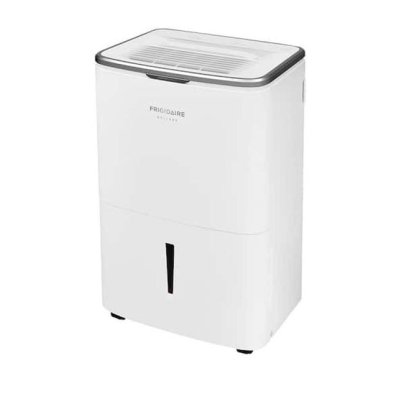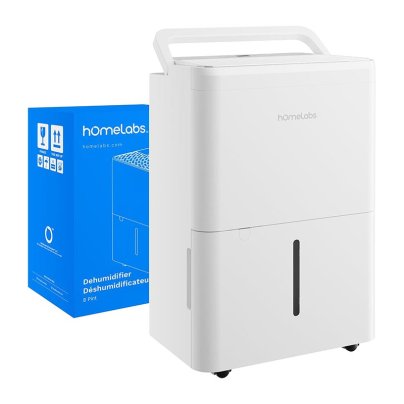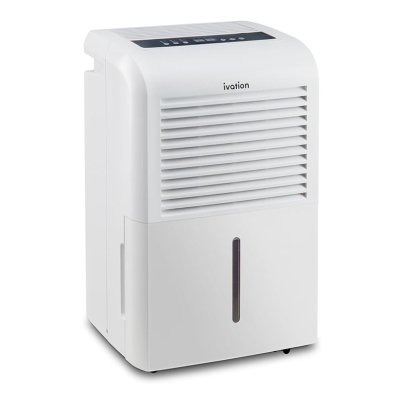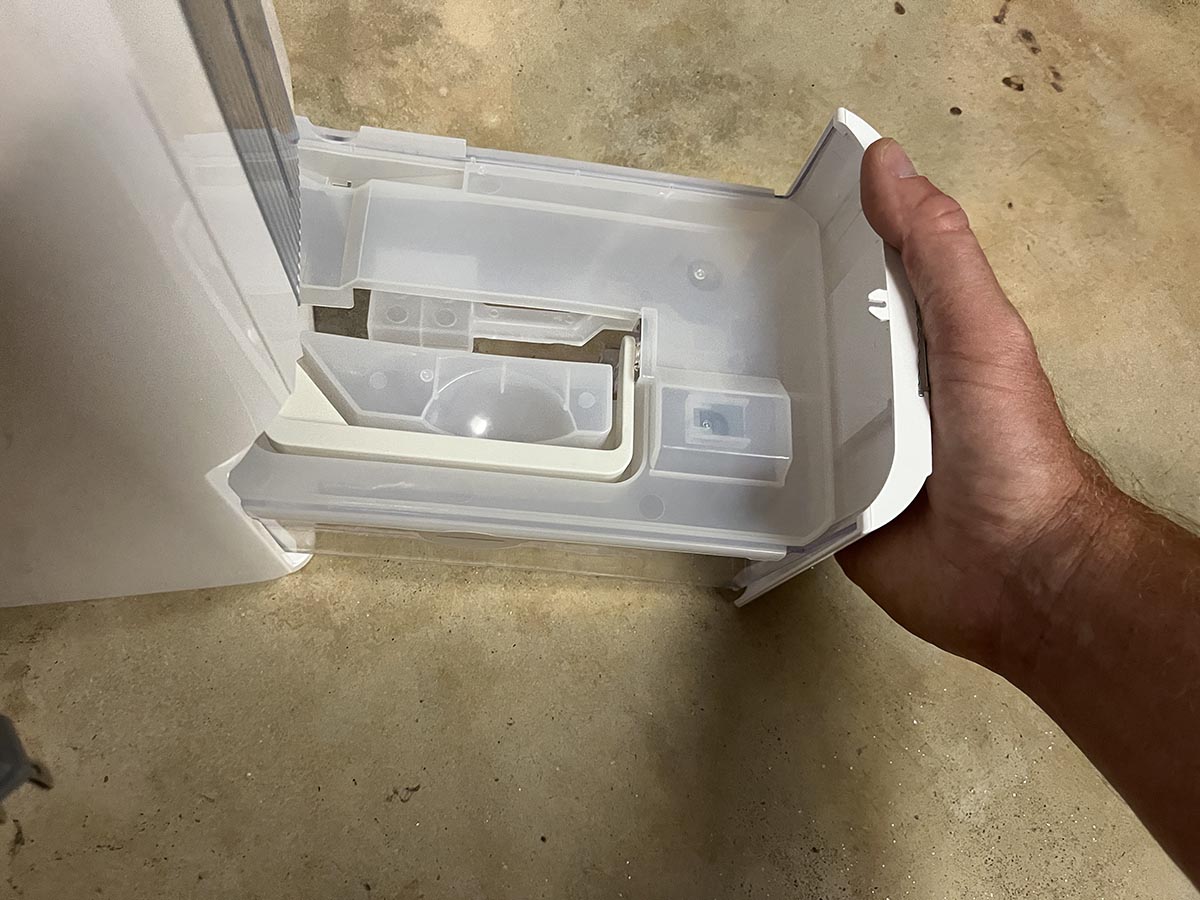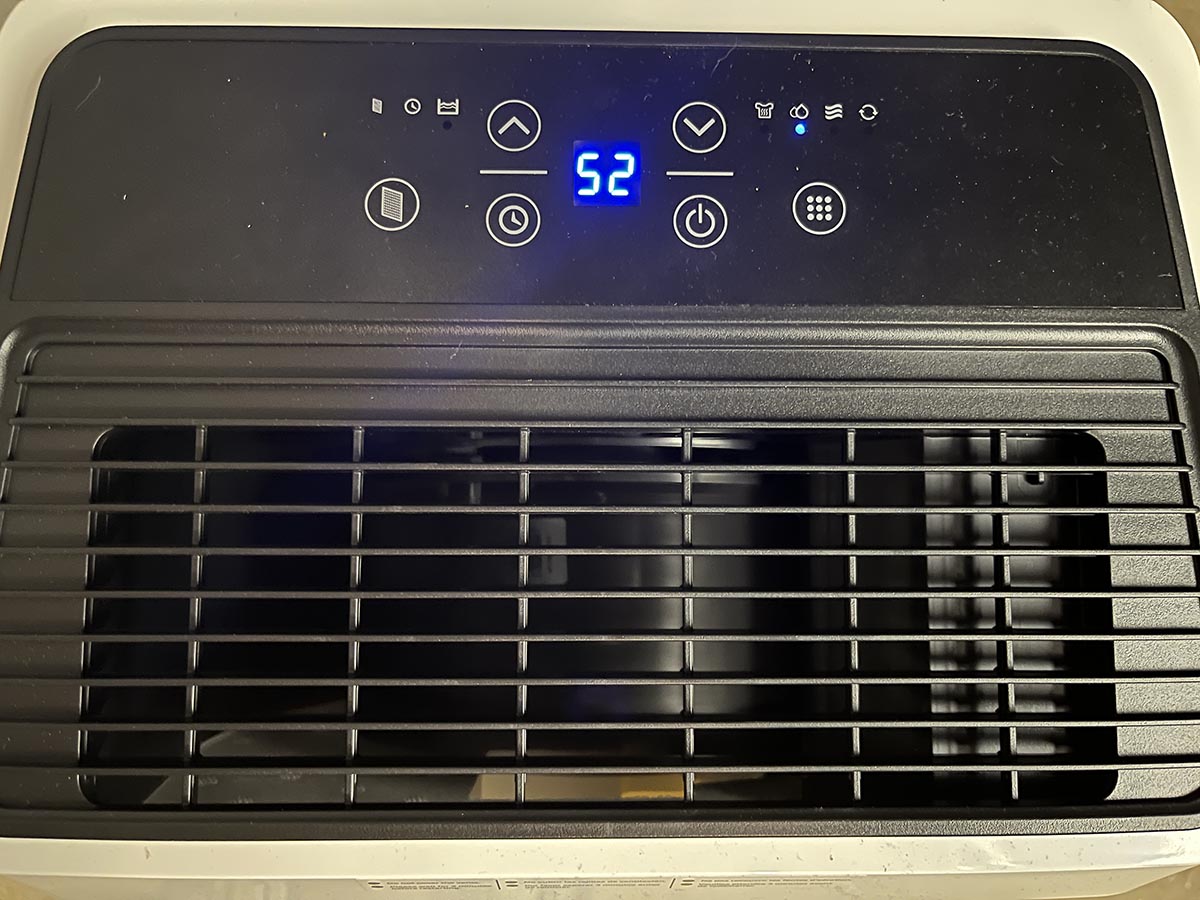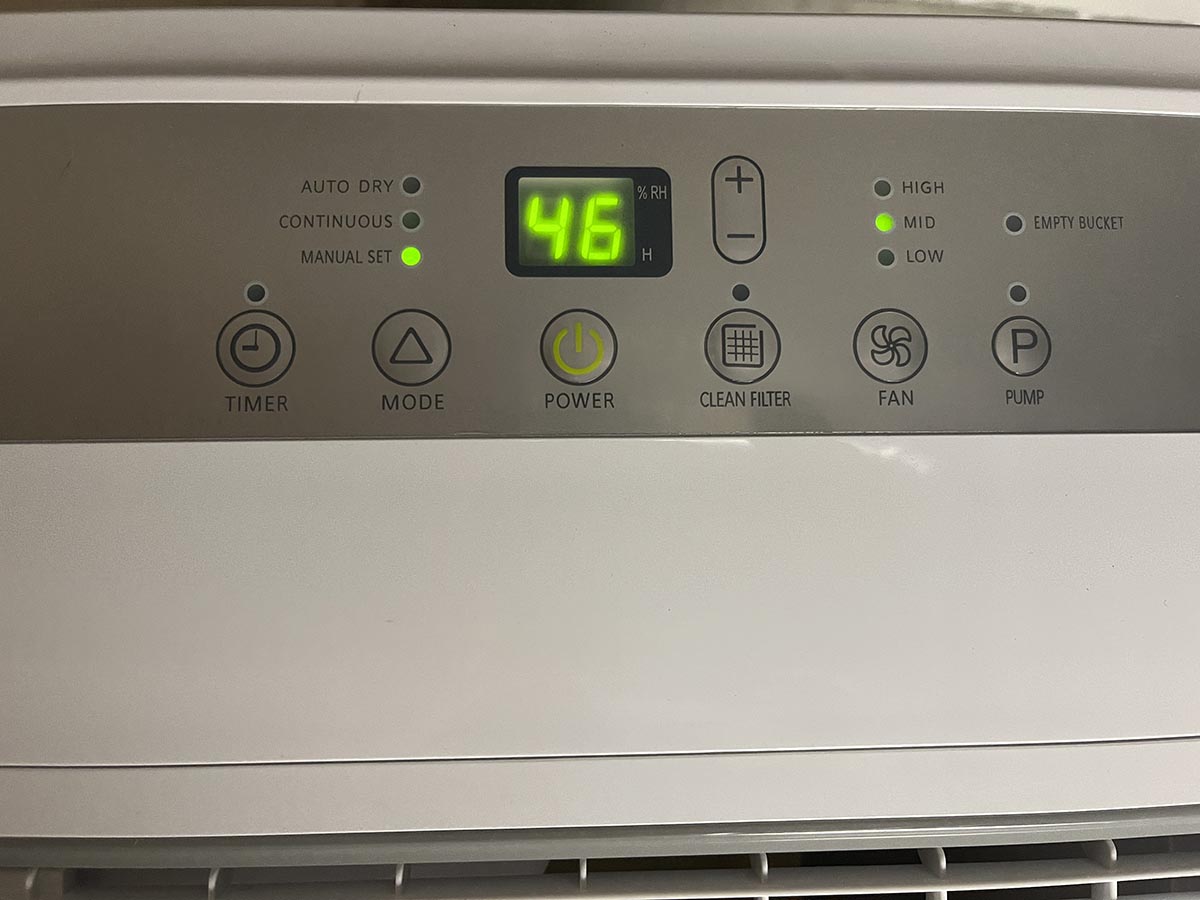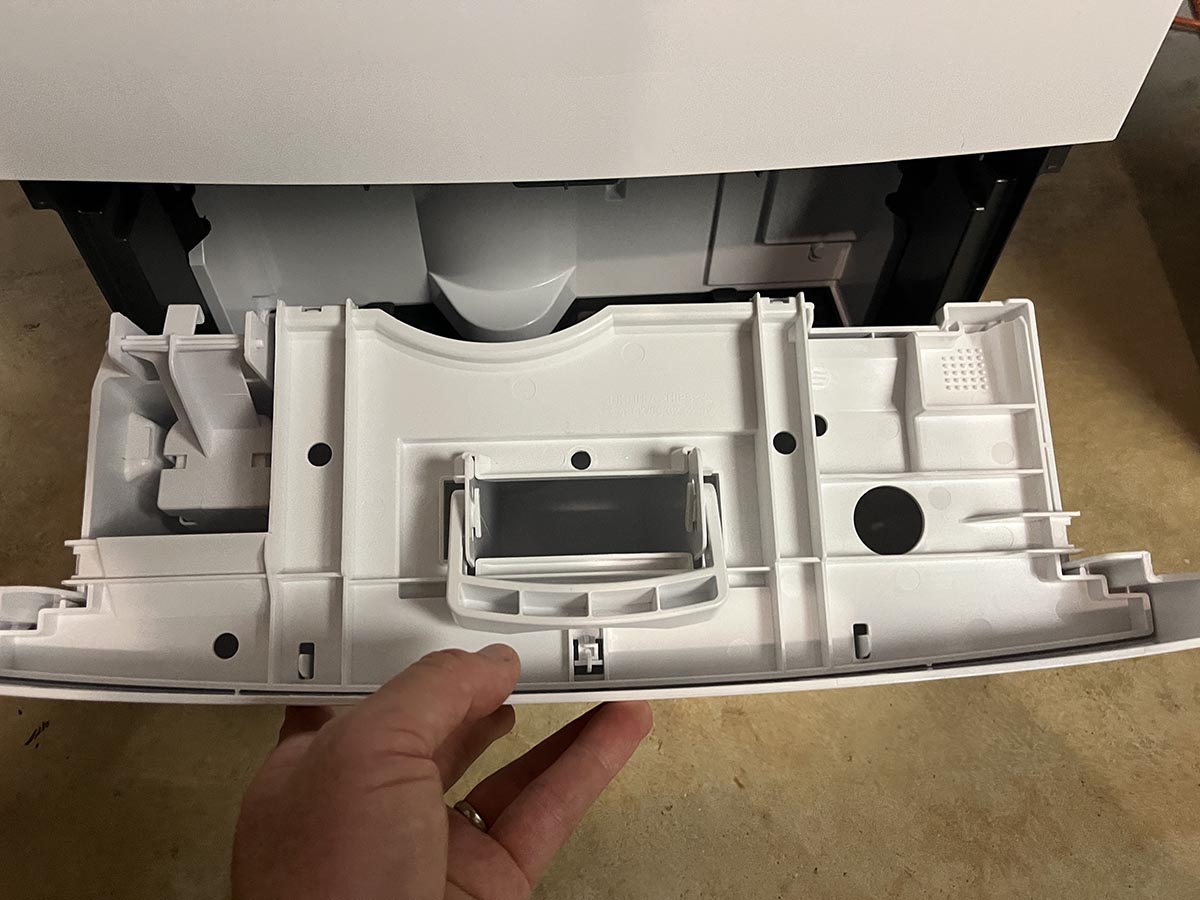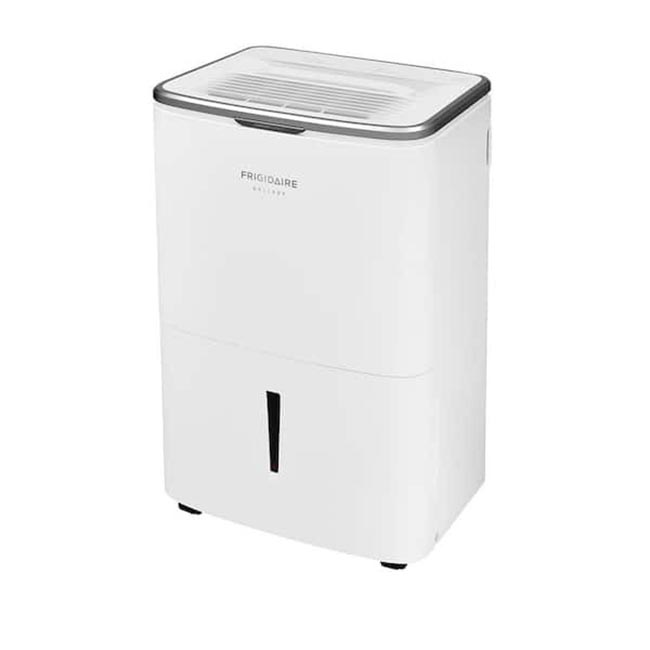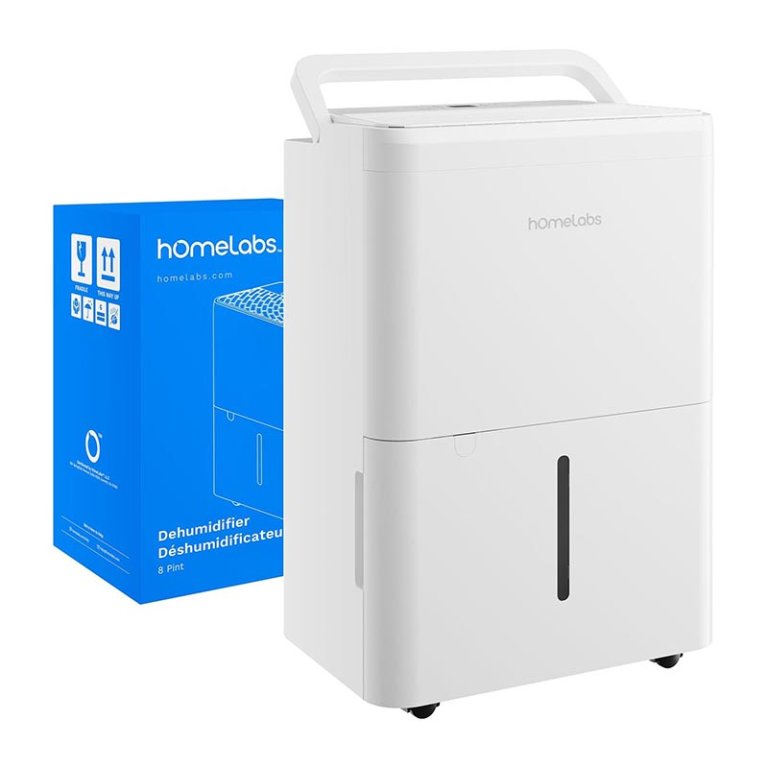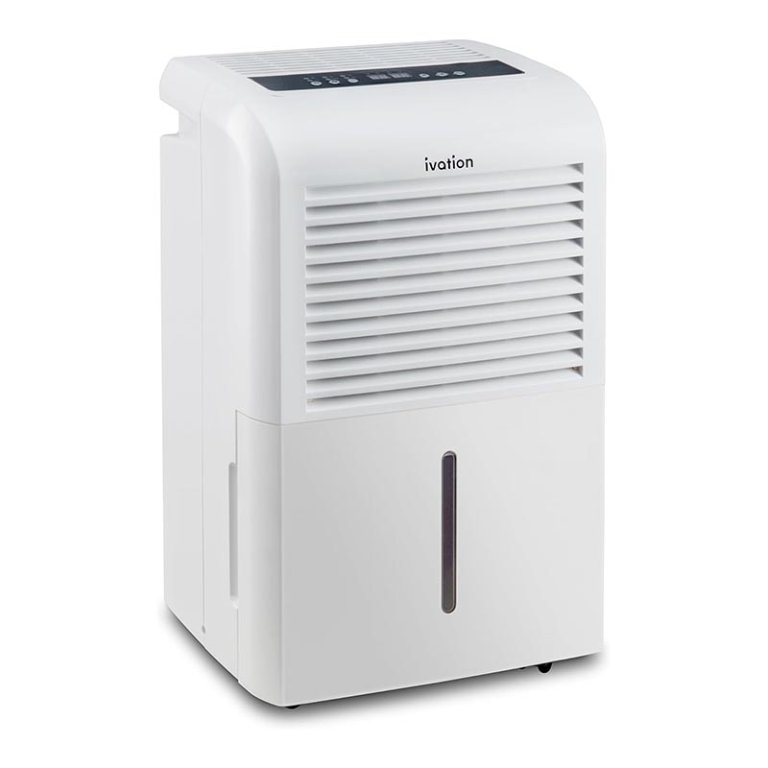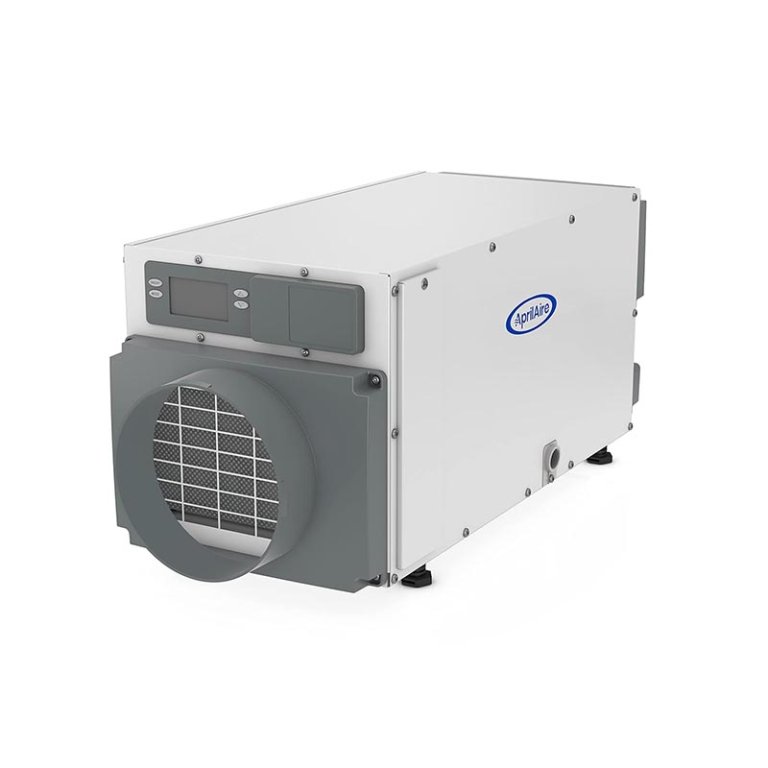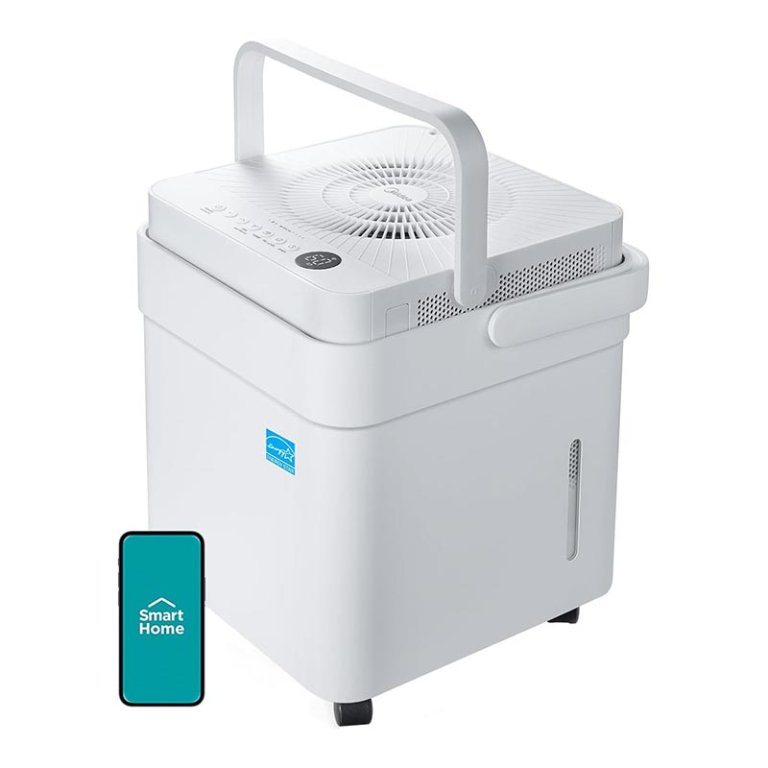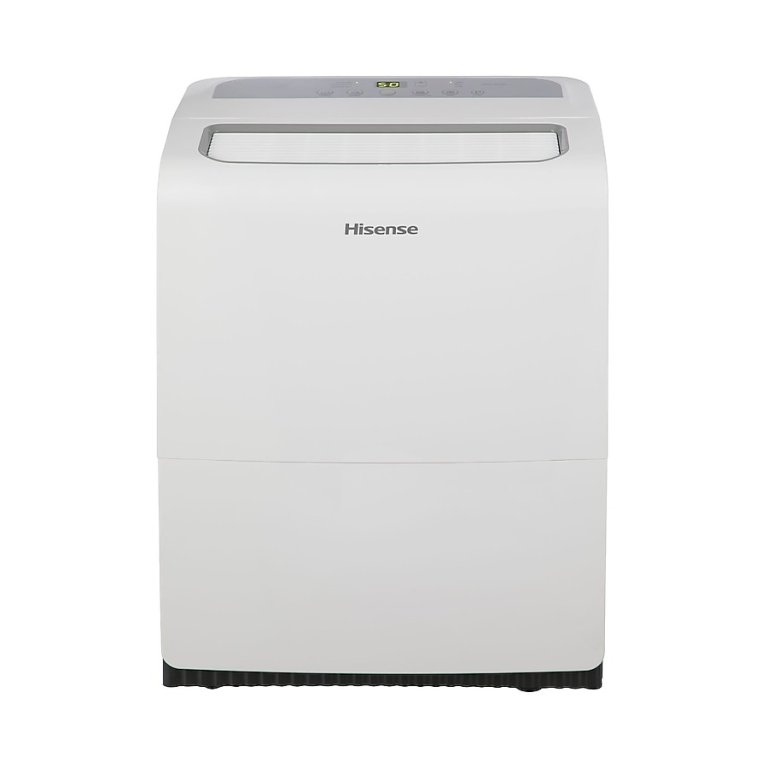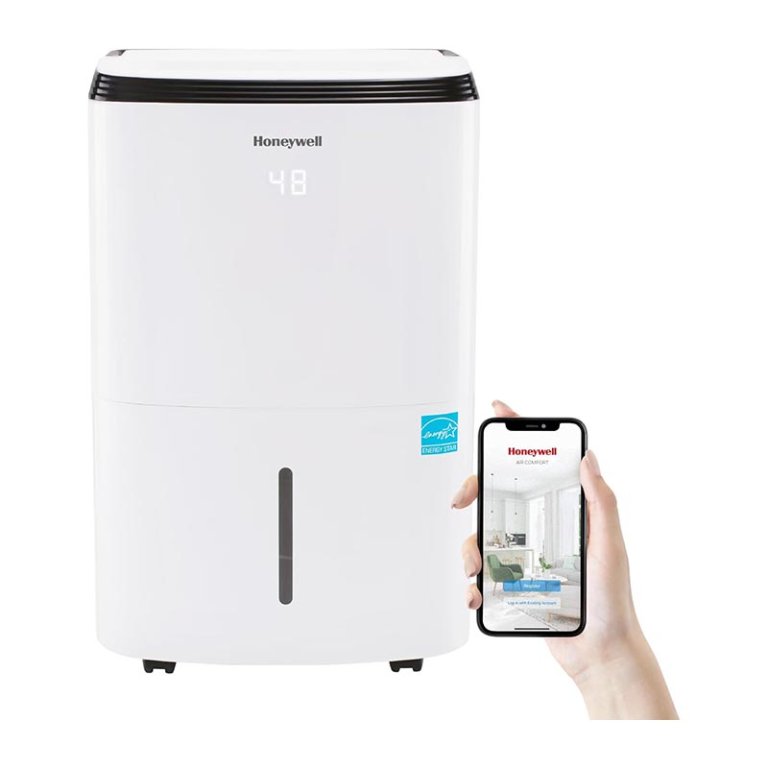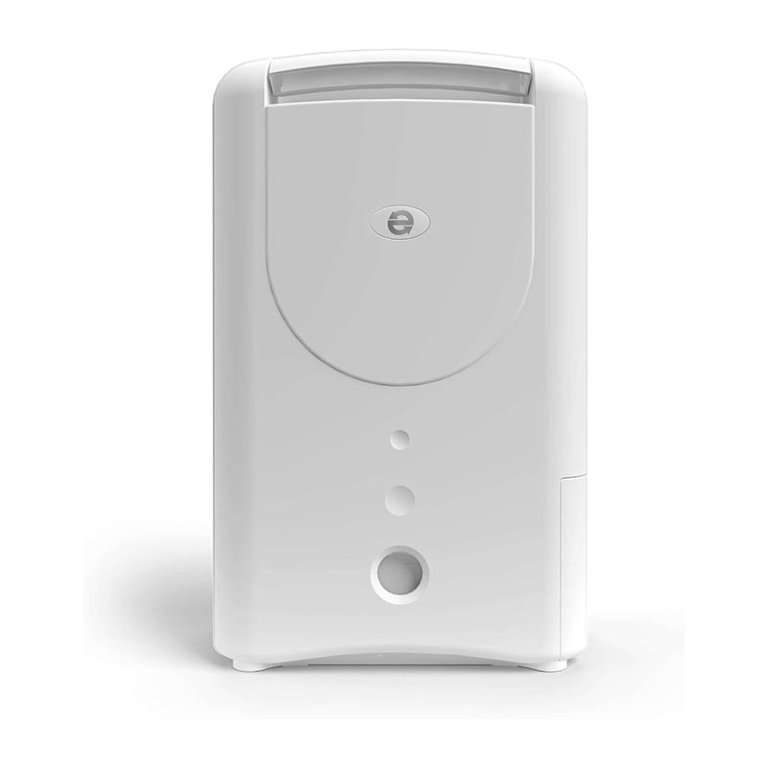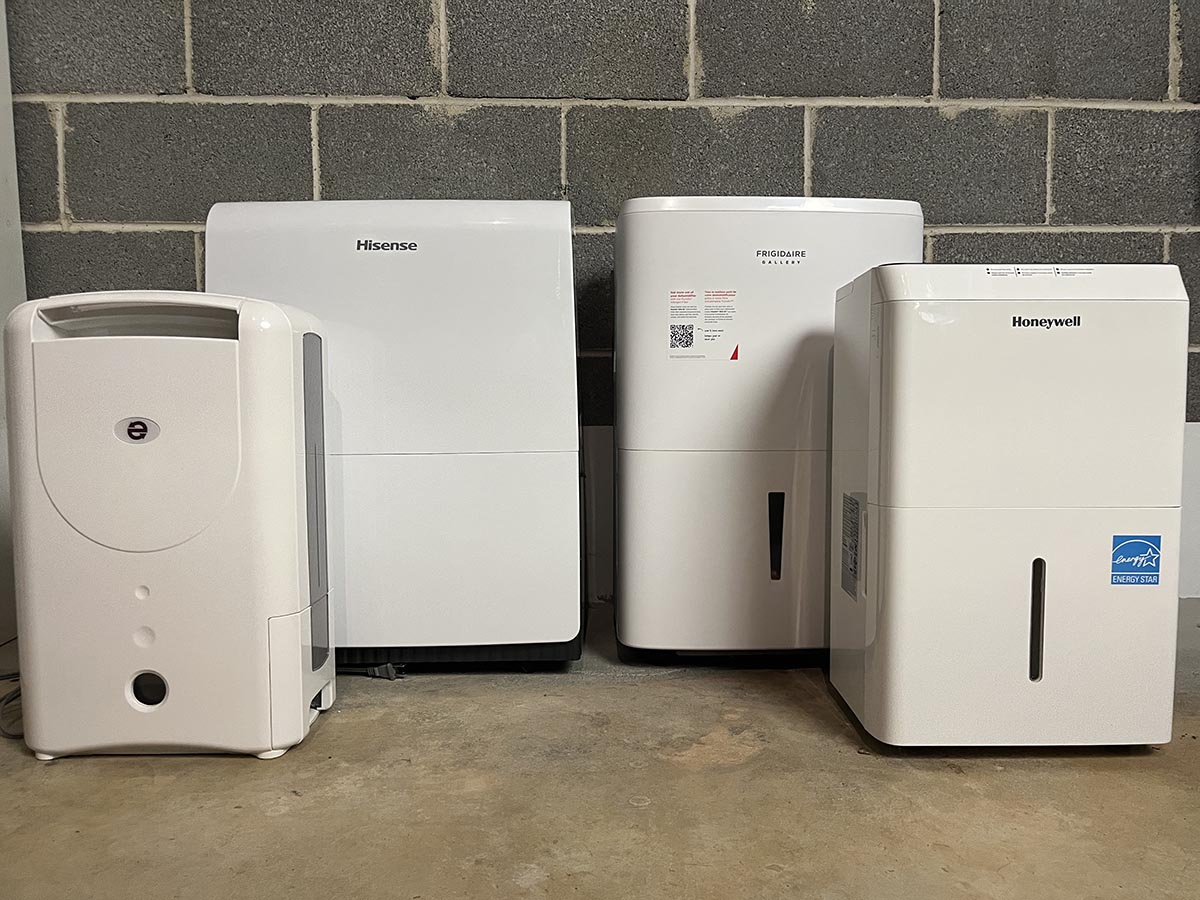
We may earn revenue from the products available on this page and participate in affiliate programs. Learn More ›
A dehumidifier is a crucial component in a well-designed heating and cooling system. Excess humidity makes indoor air feel sticky and uncomfortable, and it increases the risk of mold growth and pest problems. Dehumidifiers remove excess moisture from the air, allowing the HVAC system to work more efficiently and setting the stage for a more comfortable, healthier home. In our search for the top all-around model for home use, we tested nearly a dozen dehumidifiers. Our favorite, the Frigidaire Gallery 2-in-1 50-Pint Dehumidifier, removes up to 50 pints of moisture from the air daily in areas up to 4,500 square feet. It allows users to set target humidity levels, works with or without a drain hose, and is easy to move around and empty.
The Frigidaire dehumidifier wasn’t the only model that performed well, though. We tested a range of great options with features and settings for large and small rooms, unheated spaces, and high-humidity areas. In this guide, we’ll share the insights and observations from testing these products to help you choose the best dehumidifier for your house.
- BEST OVERALL: Frigidaire Gallery 2-in-1 50-Pint Dehumidifier
↓ Jump to Review - BEST BANG FOR THE BUCK: hOmeLabs 35-Pint 3,000-Square-Foot Dehumidifier
↓ Jump to Review - BEST FOR BASEMENTS: Ivation Large-Capacity Dehumidifier With Pump
↓ Jump to Review - BEST FOR CRAWL SPACES: AprilAire E070 70-Pint Crawl Space Dehumidifier
↓ Jump to Review - BEST FOR BATHROOMS: Midea 50-Pint Cube Dehumidifier
↓ Jump to Review - BEST FOR LARGE ROOMS: Hisense 60-Pint Built-In Pump Dehumidifier
↓ Jump to Review - BEST FOR SMALL ROOMS: Honeywell 25-Pint Energy Star Portable Dehumidifier
↓ Jump to Review - BEST FOR COLD ROOMS: Eva-Dry EDV-4000H Rotary Desicant Dehumidifier
↓ Jump to Review
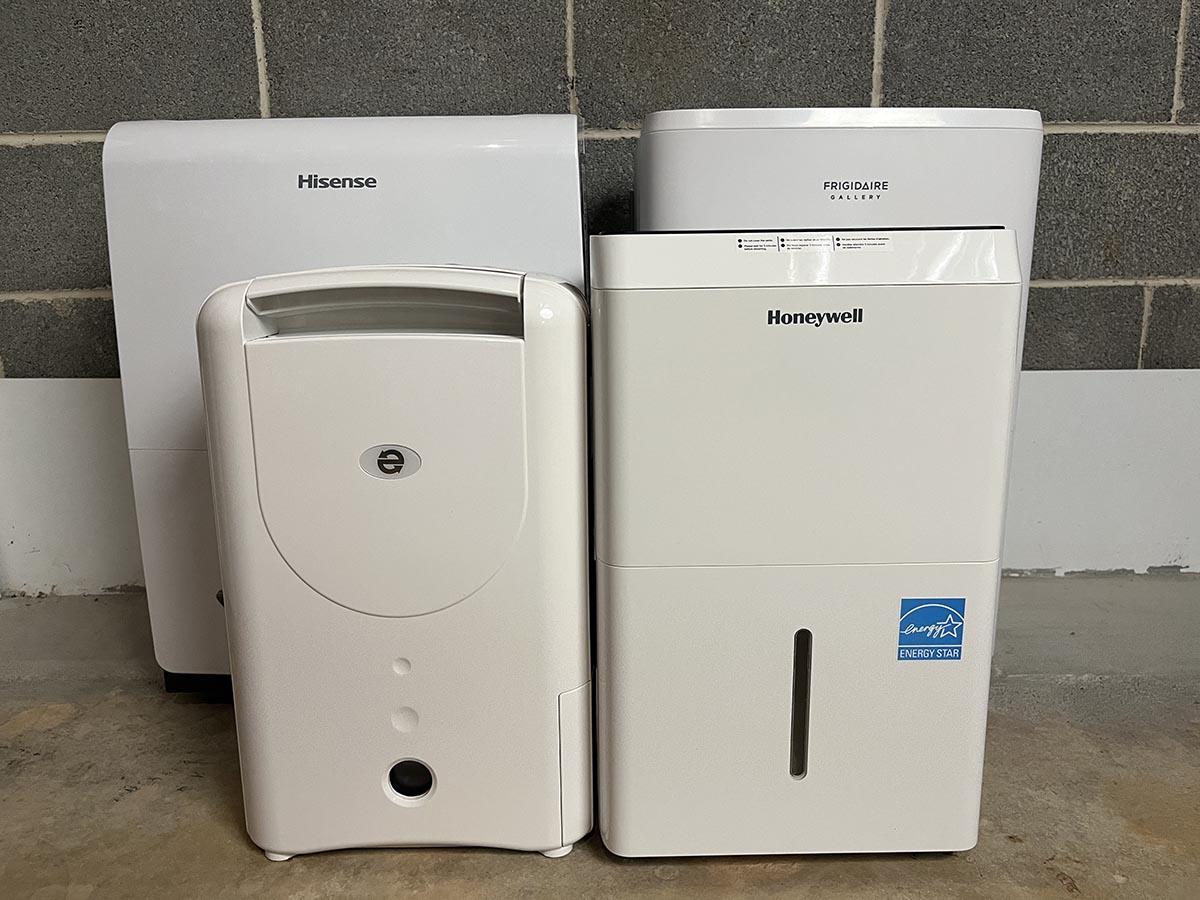
Dehumidifiers Comparison
| Product | Capacity | Coverage | Energy Star certified? | Weight |
|---|---|---|---|---|
| Frigidaire Gallery 2-in-1 50-Pint Dehumidifier | 50 pints per day | 4,500 square feet | Yes | 42 pounds |
| hOmeLabs 35-Pint 3,000-Square-Foot Dehumidifier | 35 pints per day | 3,000 square feet | Yes | 40 pounds |
| Ivation Large-Capacity Dehumidifier With Pump | 50 pints per day | 4,500 square feet | Yes | 45.4 pounds |
| AprilAire E070 70-Pint Crawl Space Dehumidifier | 70 pints per day | 2,200 square feet | No | 56 pounds |
| Midea 50-Pint Cube Dehumidifier | 50 pints per day | 4,500 square feet | Yes | 42 pounds |
| Hisense 60-Pint Built-In Pump Dehumidifier | 60 pints per day | 4,500 square feet | No | 57.3 pounds |
| Honeywell 25-Pint Energy Star Dehumidifier With Pump | 25 pints per day | 1,500 square feet | Yes | 27.1 pounds |
| Eva-Dry EDV-4000H Rotary Desicant Dehumidifier | 14.8 pints per day | 4,000 square feet | No | 13.5 pounds |
Our Top Picks
All of our top recommendations are efficient, durable, and easy to operate. The best dehumidifier for a particular home should be properly sized for the space and humidity level, and may include conveniences like continuous draining or Wi-Fi connectivity. The following dehumidifiers will remove unwelcome humidity in homes of all shapes and sizes.
Best Overall
Frigidaire Gallery 2-in-1 50-Pint Dehumidifier
See ItWhat We Like
- High-volume dehumidification capacity
- Relatively compact size
- Low noise level
- Remote control-enabled
What We Don’t Like
- Too bulky for smaller spaces
- More expensive than some similar options
Specs
- Capacity: 50 pints per day
- Coverage: 4,500 square feet
- Energy Star certified: Yes
- Weight: 42 pounds
Our Ratings: Ease of Use 4.7/5; Noise 5/5; Effectiveness 5/5; Value 4.7/5
When you’re dealing with high humidity, a high-capacity dehumidifier is the most effective way to get ahead of the problem. This Energy Star–certified Frigidaire dehumidifier removes up to 50 pints of water from the air each day. Even better, the 2-in-1 design also includes advanced filtration to purify the air. It is conveniently Wi-Fi–enabled for remote control via the Frigidaire app, or voice control using Amazon Alexa or Google Home. The wheeled base and foldaway transport handle make it easy to move from room to room or up and down the stairs as needed.

This smart dehumidifier was not the only high-capacity model we tested, but it stood out from the rest for a few reasons, starting with the convenience factor. We tested the dehumidifier in a basement, so remote monitoring and control saved countless trips up and down the stairs, as did setting it up to continuously drain into the basement sump. After assembly, the only time we had to touch it was when it was time to pack it up and test a different unit. Plus, the Frigidaire was consistently the quietest dehumidifier in the test group. We appreciate appliances that work efficiently without drawing attention to themselves.
We also liked that this was the lightest-weight and most compact of the high-capacity dehumidifiers we tested, which made it super easy to move around (a task we mainly performed during setup and removal). The collection bucket was a bit smaller than some of the others, but continuous draining made that size difference a non-factor.
What our tester says: “Portable dehumidifiers can be bulky and loud, so I really appreciated that the Frigidaire dehumidifier was relatively compact and quiet for its large capacity. I prefer appliances that do their job consistently well without drawing attention, and this one did exactly that.“—Mark Wolfe, Product Reviews tester and writer
Get the Frigidaire dehumidifier at Amazon, The Home Depot, or Frigidaire.
Best Bang for the Buck
hOmeLabs 35-Pint 3,000-Square-Foot Dehumidifier
See ItWhat We Like
- Empties via collection tank or continuous drain hose
- Turbo mode for fast dehumidifying
- Easy to operate and move
What We Don’t Like
- A little louder than some comparable models
Specs
- Capacity: 35 pints
- Coverage: 3,000 square feet
- Energy Star certified: Yes
- Weight: 40 pounds
Our Ratings: Ease of Use 4.7/5; Effectiveness 5/5; Noise 3.5/5; Value 5/5
Drying the air in your home doesn’t have to break the bank. The hOmeLabs 35-pint dehumidifier is effective in spaces up to 3,000 square feet, and it costs less than most of the other models we tested. It has built-in wheels and a carry handle for easy portability, plus essential features such as auto shutoff, a timer, and a filter indicator light.
Setting up the hOmeLabs dehumidifier was as simple as plugging it in and powering it on. We set the humidity level to 40 percent and it immediately began to reduce excess moisture in our basement. We allowed this dehumidifier to run for 2 weeks, and it removed more than 22 collective gallons of water from the air.
The collection tank filled up within 24 hours during continuous use, so we had to empty it daily. Emptying it was easy, but fortunately, this model also has a drain hose connection for continuous draining (drain hose sold separately). The hOmeLabs dehumidifier has a sleek look, is easy to move around, and doesn’t take up much space. However, it was a little louder than comparable dehumidifiers we tested.
Get the hOmelabs dehumidifier at Amazon, Wayfair, or Walmart.
Best for Basements
Ivation Large-Capacity Dehumidifier With Pump
See ItWhat We Like
- Includes 16-foot hose for continuous operation
- Maintains humidity levels in large spaces
- Includes timer, auto shutoff, and frost sensor features
What We Don’t Like
- A bit noisy
Specs
- Capacity: 50 pints
- Coverage: 4,500 square feet
- Energy Star certified: Yes
- Weight: 45.4 pounds
Our Ratings: Ease of Use 4.5/5; Noise 4/5; Effectiveness 4.5/5; Value 4/5
A basement is often the most humid spot in the house, but with this large-capacity dehumidifier from Ivation, basements can stay dry and comfortable. It comes with a 2.25-gallon collection tank, but it operates best when connected to a drain hose for continuous draining into a sump or floor drain.
Designed to reduce humidity in areas up to 4,500 square feet, the Ivation is powerful enough to tackle the toughest humidity problems, making it an ideal dehumidifier for mold issues in the basement. It’s also simple to operate: Users can choose either timed mode or continuous mode, which means the unit will run until it’s shut off or the tank fills.
The Ivation dehumidifier for basements comes with a 16-foot hose for continuous use, but we also tested its collection bucket. Among the large-capacity dehumidifiers we tested, this one had the longest runtime before it needed to be emptied. It was easy to move, and the onboard condensate pump allowed us to empty the unit into a sink drain. We appreciated this unit’s auto-restart feature, which powers it back on in the event of a power failure. It also has an auto-defrost sensor that protects its evaporator coils.
Get the Ivation dehumidifier at Amazon, The Home Depot, Wayfair, Walmart, or Target.
Best for Crawl Spaces
AprilAire E070 70-Pint Crawl Space Dehumidifier
See ItWhat We Like
- Large water-removal capacity for big crawl spaces
- Features corrosion-resistant aluminum coils
- Automatic dehumidifier; activates when humidity exceeds target level
- Gravity drain system
What We Don’t Like
- Can’t pump to an elevated drain
- Heavier than other models with similar capacity
- Requires a sealed crawl space for best results
Specs
- Capacity: 70 pints
- Coverage: 2,200 square feet
- Energy Star certified: No
- Weight: 56 pounds
Our Ratings: Ease of Use 5/5; Noise 5/5; Effectiveness 5/5; Value 4/5
Homes in rainy regions with sealed crawl spaces are at high risk of humidity-related problems. When you need serious moisture reduction in a humid crawl space to protect your home’s structure, consider a unit like the AprilAire E070. This dehumidifier for a house’s crawl space removes up to 70 pints of moisture per day, and there’s no collection tank to dump. Instead, it automatically empties the water through a hose (included) outside the home or to a floor drain.
We had previously tested five popular crawl space dehumidifiers, and while this was one of the most expensive, it was the clear winner in ease of use and effectiveness. It had a simple interface and a large display that made it easy for us to set up. It also boasts other valuable features, including corrosion-resistant aluminum coils, a gravity drain, and a washable air filter to ensure it will operate smoothly for years.
Thanks to the easy-to-follow directions, installing this dehumidifier took us only 15 minutes. The starting humidity level in our crawl space was 70 percent. After 12 hours, it dropped to 58 percent, and within 24 hours, it was at 49 percent. The dehumidifier continued to run intermittently, keeping humidity levels in the mid-40s.
Get the AprilAire dehumidifier at Amazon or The Home Depot.
Best for Bathrooms
Midea 50-Pint Cube Dehumidifier
See ItWhat We Like
- Large 4.2-gallon collection bucket
- Great for high-humidity areas
- Ability to control from smartphone app
- Continuous drain option
What We Don’t Like
- Heavy and awkward to empty
- App’s features are limited
Specs
- Capacity: 50 pints
- Coverage: 4,500 square feet
- Energy Star certified: Yes
- Weight: 42 pounds
Our Ratings: Ease of Use 3.7/5; Noise 4/5; Effectiveness 5/5; Value 3.3/5
The unique combination of high humidity and limited space in bathrooms calls for a high-capacity dehumidifier with a small footprint. If you’re looking for something that fits that description, the Midea 50-pint cube dehumidifier is an option worth considering. Its cube shape is space-efficient, and it packs ample dehumidification power. The unique nested design simplifies storage, and it’s easy to lift and twist the sections apart when it’s time to use.
The Midea dehumidifier felt heavier than its actual weight because of its bulky cube shape. To set it up, we lifted the top unit and placed it on supports built into the water collection bucket, carefully lining up arrows for correct installation. We connected the app and set a target humidity level of 40 percent. It only took 2 hours for the Midea to bring our basement’s humidity level from 55 percent to 40 percent. For the next 24 hours, humidity levels remained in the low to mid-40s.
About 24 hours after the initial setup, the Midea app notified us that the bucket was full. To empty this large dehumidifier, we had to lift the top unit from the bucket, set it on the floor, and pour the collected water out of the bottom bucket. The dehumidifier weighs just under 42 pounds in total, with most of the weight concentrated at the top dehumidifying unit. While this unit is efficient and has smart features, we don’t recommend it to those who have difficulty lifting heavy objects.
Get the Midea dehumidifier at Amazon or The Home Depot (with pump).
Best for Large Rooms
Hisense 60-Pint Built-In Pump Dehumidifier
See ItWhat We Like
- High dehumidification capacity
- Easy, intuitive control panel
- High airflow for large areas
- Low operating noise
- Continuous drain option
What We Don’t Like
- Not Energy Star certified
- More expensive than similar options
Specs
- Capacity: 60 pints per day
- Coverage: 4,500 square feet
- Energy Star certified: No
- Weight: 57.3 pounds
Our Ratings: Ease of Use 4.7/5; Noise 5/5; Effectiveness 5/5; Value 4.3/5
It takes high airflow and high capacity to control humidity in larger rooms, and the Hisense 60-pint dehumidifier offers both. This was the largest-capacity portable unit among our test group, and its 3-speed fan moved more air than the others, too. It also comes with a quick-connect drain hose for convenient continuous draining—even to an elevated drain, thanks to the built-in pump.
The Hisense dehumidifier had simple touch controls that were well designed and easy to operate. LED indicator lights clearly showed if the bucket was full or the filter was dirty. This unit lowered the moisture level within the target range faster than any of the other portable dehumidifiers, and it operated remarkably quietly.
Just bear in mind that bigger capacity and more power comes with larger size. At 57 pounds, this was the heaviest unit we tested. Rolling it around on wheels was not difficult, but moving it up and down stairs required a bit more physical strength than most of the others. It was also one of the few models we tested that is not Energy Star certified.
Get the Hisense dehumidifier at Lowe’s.
Best for Small Rooms
Honeywell 25-Pint Energy Star Portable Dehumidifier
See ItWhat We Like
- Lightweight, compact, easy to transport and store
- Energy Star “most efficient” qualified
- Includes laundry and auto comfort modes
- Removable bucket and continuous drain option
What We Don’t Like
- Touch controls can be finicky
Specs
- Capacity: 1,500 square feet
- Coverage: 1,500 square feet
- Energy Star certified: Yes
- Weight: 27.1 pounds
Our Ratings: Ease of Use 4.7/5; Noise 5/5; Effectiveness 5/5; Value 4.7/5
Small rooms like bathrooms and laundry rooms can be sources of home humidity issues, and that’s where this Honeywell 25-pint dehumidifier shines. The compact, high-efficiency model dries the air quickly without running up the electricity bill. It qualifies for the highest Energy Star rating, and it includes auto-comfort and laundry mode settings.
In our basement test, the Honeywell dehumidifier worked quietly and pulled about 95 pints of water from the air throughout the week. However, it did not have adequate capacity to keep up with the humidity in the big, open basement, so it ran constantly. After the initial test, we moved it to a poorly vented bathroom where it did a great job drying the air, walls, and even the towels within an hour or so of shower time.
The small size of this model was perfect for bathroom use. It packed plenty of drying power for the small space but didn’t get in the way, and it was small enough to stow in the bottom of the linen closet when not in use. We also noted that it was almost whisper quiet in operation, compared to the noisy bathroom exhaust fan.
What our tester says: “The Honeywell dehumidifier was absolutely perfect for the occasional high humidity in my midsize bathroom. It truly impressed me by drying the room in less than an hour—not only the air but the walls and towels too.”—Mark Wolfe, Product Reviews tester and writer
Get the Honeywell dehumidifier at Amazon, Walmart, or Macy’s.
Best for Cold Rooms
Eva-Dry EDV-4000H Rotary Desicant Dehumidifier
See ItWhat We Like
- Compact and lightweight
- Works in temperatures down to 34 degrees Fahrenheit
- Very quiet operation
What We Don’t Like
- 14.8 pints per day
Specs
- Capacity: 14.8 pints per day
- Coverage: 4,000 square feet
- Energy Star certified: No
- Weight: 13.5 pounds
Our Ratings: Ease of Use 4.7/5; Noise 5/5; Effectiveness 4.7/5; Value 4/5
Cold rooms, unheated basements, garages, and winterized RVs benefit from dehumidification, but refrigerant-based appliances work less efficiently in cold temperatures. This rotary desiccant dehumidifier from Eva-Dry solves that problem, operating efficiently in temperatures down to 34 degrees Fahrenheit.
We maxed this little unit out during our basement tests. It topped its reservoir twice a day, but didn’t make much of a dent in the humidity of the large, open space. It did a great job later on when we set it up in a damp bathroom, though, drying it out within 60 minutes after showers.
The Eva-Dry desiccant dehumidifier was remarkably quiet in operation, with a noise level of about 32 decibels on the lowest setting. It was also the smallest and lightest model we tested (just over 13 pounds), but the unique technology made it more expensive than conventional refrigerant-based dehumidifiers of similar capacity.
Get the Eva-Dry dehumidifier at Amazon, Ace Hardware, or Eva-Dry.
Jump to Our Top Picks
How We Tested the Best Dehumidifiers
| Testing Stats | |
| Products tested | 11 |
| Time spent testing | 6 weeks |
| Amount of water removed from air | 2,100 pints |
| Price range | $50 to $1,500 |
Our goal for this guide was to showcase a variety of dehumidifier types and sizes that could solve our readers’ diverse home humidity problems. We researched more than 40 models and 10 manufacturers before choosing 11 for testing. We then tested each one for 7 days in a large, open basement where humidity levels ranged between 40 and 70 percent. We evaluated their ability to reduce humidity and maintain a targeted humidity level, ease of operation, noise, and convenience features. We also noted how the air felt and smelled while each dehumidifier ran. All results were recorded in a standardized rubric, where we assigned each dehumidifier a score of 0 to 5 based on ease of use, effectiveness, noise, and value.
| Product | Ease of Use | Noise | Effectiveness | Value |
| Frigidaire Gallery 2-in-1 50-Pint Dehumidifier | 4.7 | 5 | 5 | 4.7 |
| hOmeLabs 35-Pint 3,000-Square-Foot Dehumidifier | 4.7 | 5 | 3.5 | 5 |
| Ivation Large-Capacity Dehumidifier With Pump | 4.5 | 4 | 4.5 | 4 |
| AprilAire E070 70-Pint Crawl Space Dehumidifier | 5 | 5 | 5 | 4 |
| Midea 50-Pint Cube Dehumidifier | 3.7 | 4 | 5 | 3.3 |
| Hisense 60-Pint Built-In Pump Dehumidifier | 4.7 | 5 | 5 | 4.3 |
| Honeywell 25-Pint Energy Star Portable Dehumidifier | 4.7 | 5 | 5 | 4.7 |
| Eva-Dry EDV-4000H Rotary Desicant Dehumidifier | 4.7 | 5 | 4.7 | 4 |
What to Consider When Buying a Dehumidifier
Humidity is directly related to comfort, and humidity levels higher than 50 percent will make a room feel sticky during hot weather and downright chilly when the temperature drops. If you’re unsure whether your home would benefit from a dehumidifier, purchase an air quality monitor to assess humidity levels beforehand. In addition to selecting the right type of dehumidifier for your situation, consider the following factors.
Types of Dehumidifiers
Dehumidifiers can work in various ways to remove moisture from the air. Whether you need just a little drying action or a lot, the dehumidifier you choose will be one of the following three types.
Refrigerant
A refrigerant dehumidifier works by cooling a steel surface within the machine, and when air is drawn over the cold steel, the moisture in the air condenses—much like what happens when warm air condenses on the side of a glass of iced tea. The condensation is collected in a tank or drains from a hose into a floor drain. Refrigerant units work best in rooms where the temperature is more than 65 degrees Fahrenheit; at lower temperatures, condensation is less significant.
Desiccant
Sometimes called “chemical absorbent dehumidifiers,” desiccant units feature internal cartridges made from moisture-absorbing gel or powder. As air flows into the machine, the desiccant collects the moisture, which then drains into a collection tank or out via a drain hose. This type of dehumidifier works well in warm and cold temperatures, making it well suited to a cool basement or garage workshop.
Whole-House System
A whole-house dehumidifier is installed on a home’s central HVAC duct and removes moisture from the air whenever the furnace or air conditioner is running. Whole-house dehumidifiers work well in humid climates where homeowners would otherwise need to run multiple dehumidifiers to keep the indoor humidity at an acceptable level. To ensure proper installation, a licensed HVAC technician should install a whole-house dehumidifier.
Hose Connection
Some smaller dehumidifiers have collection tanks that must be manually removed and dumped when they get full. Larger dehumidifiers with pumps often have a collection tank in addition to a hose connection that allows the user to run a drain hose from the dehumidifier to a floor drain or a sump pump. The connection accepts a standard garden hose, which is typically sold separately.
Filter Indicator
Most models come with filters that need to be replaced or washed when they become clogged to keep dust and dirt from entering the working parts of a dehumidifier. The dehumidifier may have a filter light that comes on, or, in some cases, it might throw a digital error code to indicate that the filter is dirty, indicating the unit is struggling to draw air through the clogged filter. When a filter is clogged, the unit’s effectiveness is reduced.
Automatic Humidistat
As long as a dehumidifier is running, it’s lowering humidity in the house, but once the humidity level in the room falls below 30 percent, a dehumidifier doesn’t offer much benefit. If it comes with an automatic humidistat, you won’t have to manually switch the unit on and off to control the humidity. Instead, you can select the humidity level that feels best to you. The machine will automatically monitor the air’s moisture and turn on only when the humidity exceeds that number. When the humidity level drops, the unit will turn off again.
Capacity
According to the United States Department of Energy standards, a dehumidifier’s capacity is the amount of water that it pulls from the air in 24 hours. The capacity is shown in pints per day (or PPD). Portable dehumidifiers are factory tested at 65 degrees Fahrenheit with 60 percent relative humidity. Performance varies depending on actual temperature and humidity level.
Capacity and collection-tank size are not the same thing, however. A 20-pint dehumidifier might have a 1-gallon (8-pint) collection tank that needs to be dumped repeatedly to reach the 20-pint total in a day. If a room is moderately humid, meaning the humidity level is around 65 percent to 70 percent, this formula can help determine the best dehumidifier size for a given space:
- For rooms up to 500 square feet, choose a dehumidifier with a 10-pint capacity.
- For larger spaces, add 4 pints of capacity for each additional 500 square feet.
- For example, a 1,500 square foot damp space needs at least 18 PPD capacity.
If the humidity is 70 percent or higher, higher capacity will be needed.
- 12 PPD capacity for the first 500 square feet
- An additional 5 PPD capacity for each additional 500 square feet
- For example, a 1,500 square foot wet space needs at least 22 PPD capacity.
The Advantages of Using a Dehumidifier
Keeping a home’s humidity level manageable can make its occupants feel more comfortable and protect the home and its contents.
- Lower humidity reduces the risk of mold and mildew growth.
- A dehumidifier will make a room feel more comfortable all year long.
- High humidity levels can lead to condensation forming on windows and even walls.
FAQs
If this is your first time shopping for a dehumidifier, you likely have some questions, some of which we hope to answer below.
If you want to move it from room to room, get a portable unit. If there’s nowhere to run a drain hose, you’ll have to settle for a dehumidifier that requires manual dumping. And if you want your entire house dehumidified, opt for a whole-house unit.
For it to work most effectively, the best spot to place a dehumidifier is usually where it’s the most humid, such as in a kitchen, laundry room, unvented bathroom, or basement.
This will depend on how often the machine is running. Many of today’s models come with a filter warning light that indicates when you should clean or replace a dirty filter.
Depending on their size, dehumidifiers can use a lot of electricity. To find an energy-efficient dehumidifier, look at the wattage and opt for Energy Star–certified models.
The average lifespan of a dehumidifier is about 8 years, but it can vary based on care, use patterns, and wear and tear.
Avoid using some dehumidifiers in cold temperatures. Below 60 degrees Fahrenheit, refrigerant dehumidifiers may be susceptible to freezing damage as the moisture that is removed from the air condenses and freezes on the coils.
When in doubt, go bigger. Larger-capacity dehumidifiers will tackle modest moisture, but undersized dehumidifiers will wear out prematurely if they are overworked.
A humidity range between 30 and 50 percent is widely considered ideal for comfort, as well as minimizing mold and pest problems. If you feel your house is consistently more humid than it should be, there may be a few reasons why.
In high-humidity areas, it may be helpful to run a dehumidifier constantly, and it is perfectly fine when needed. But doing so increases power consumption and may not be required for the desired effect.
Meet the Tester
Katie Barton has over 10 years of experience in home and garden writing. She has authored hundreds of articles for major media outlets, and her work has been featured on GOBankingRates, Realtor.com, Yahoo!, Cabin Life, and more. She takes an unbiased approach to product testing, using each product multiple times or for several days or weeks to determine efficacy.
Mark Wolfe is a writer, product tester, and serial DIYer. When he isn’t writing, he spends his time upgrading, repairing, and replacing anything and everything in his home, yard, and garden. He tests and writes reviews about hand and power tools, lawn care and home repair products, and outdoor living goods.
Additional research provided by Glenda Taylor.
